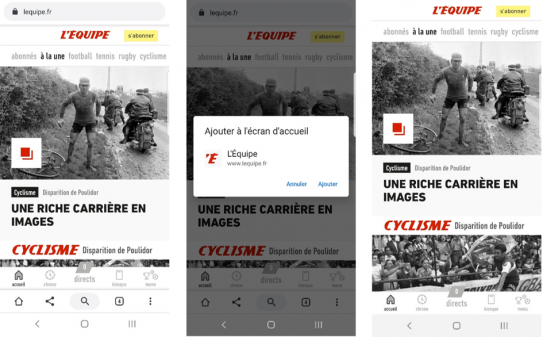
Progressive Web Apps, a powerful new mobile-deployable tool
In an article entitled “A mobile app at any price?”, I highlighted how difficult it is for brands to get mobile internet users to download a mobile app… and use it.
The “chosen ones”, i.e. the brands whose apps are used on a daily basis, really are few and far between; but what’s left for the other brands that are only visited via a web browser? Perhaps the possibility of getting as close as possible to a native experience via a Progressive Web App, or PWA.
What’s a Progressive Web App?
A PWA is quite simply a web app that attempts to offer the best of both worlds, i.e. web and app stores. It doesn’t have to be downloaded because it’s accessible via a browser; it offers an experience similar to that of a native mobile app downloaded from App Store or Play Store. There are major advantages to a PWA: no need for installation on your mobile, accessibility via an icon installed on your home screen, the option of offline use, even with a low-speed connection. What’s more, it offers a range of native features, particularly full-screen display, push notifications, geolocation and a camera. Though a mobile strategy is a must for many brands, you don’t necessarily need a downloadable application.
PWAs to solve acquisition and loyalty development issues
Many brands have got in on the action, from social networks like Twitter, Instagram, Pinterest and even Tinder, to media (L’Equipe, Forbes, Financial Times), as well as famous brands like Uber, Starbucks, Lancôme, and even AliExpress. With a PWA, they can reach a wider target audience; being accessible via a browser without having to visit a store makes acquisition easier. They can then adopt an acquisition strategy; consumers don’t have to directly engage with the brand as they don’t need to install an application. At the same time, the smartphone-based experience they enjoy meets their expectations. As time passes and visitors return time and again, brands progressively engage consumers via calls-to-action using push notifications, starting with a prompt to install a shortcut icon on their home screen. The experience then becomes increasingly progressive. In other words, the more the PWA is used, the richer the interactions become. The relationship with the consumer, who is not a client, develops and strengthens; this is how brands can solve their loyalty development issues.

In the case of L’Equipe, a mobile internet user first visits the newspaper’s website to read some sports news. After several visits, a pop-in suggests adding the site to their home screen; all they have to do it click on it to visit the site. We can see on the 3rd screen that the display is optimised. The PWA’s potential is starting to be developed with this first stage.
PWAs to optimise ROI for digital projects
In addition to an improved web experience and an enhanced acquisition and loyalty development strategy, a PWA is the perfect solution for optimising ROI, the true driving force behind any business. By focusing on a single mobile channel, the web, acquisition and loyalty development costs are naturally reduced. Let’s also not forget that a native application needs a big budget, covering development costs (for iOS and Android environments), update and maintenance costs, and in-store promotional expenses. Why not reallocate this budget? Several key budget items could do with it, particularly SEO/SEA strategy, UX design and content creation.
These activities are crucial for brands looking to make the most of the web. There’s no reason not to go PWA-exclusive based on the sector, brand awareness, marketing budgets, and targeting needs. If using a PWA is an option, brands can decide to opt for the development of a native application. This is also the privilege of the “chosen ones”, big businesses and pure players like Uber and AliExpress that are aiming for ubiquity, by simultaneously targeting loyal users via an application downloaded onto their mobile, and users via a web browser.
By combining the best of both worlds, i.e. web and native, Progressive Web Apps close the gap between responsive sites and applications and meet a user need, which was previously poorly met by brands. A PWA is essential to achieving the strategic objectives of many businesses, since it is an easy solution to adopt and deploy, effectively achieving tangible results. So, before committing to creating a mobile app, think progressively!
Published on JDN